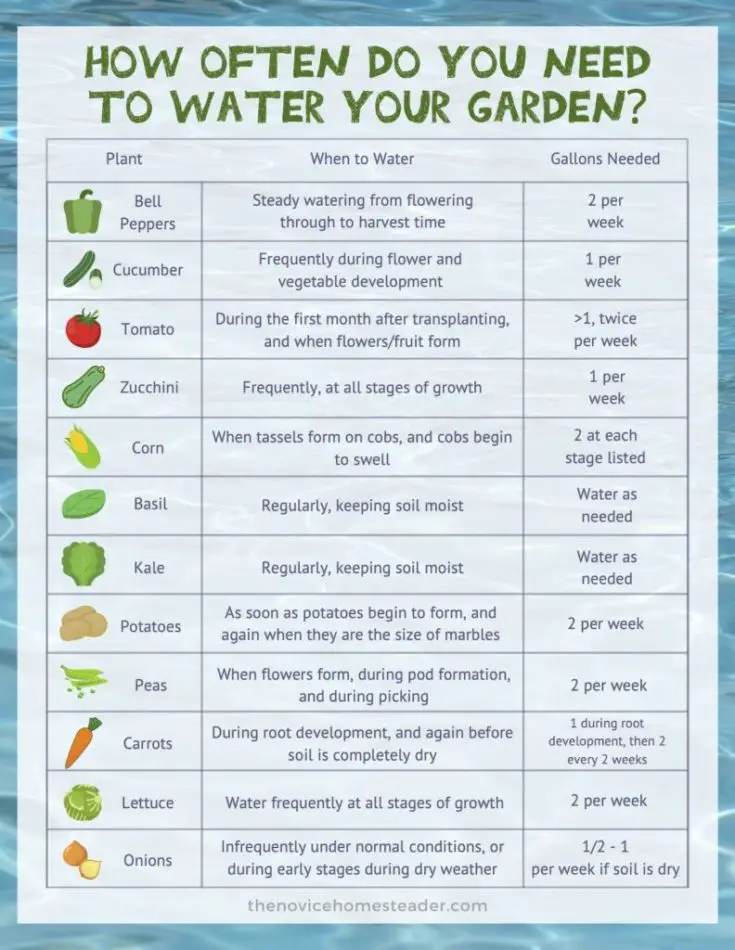In today’s world, many people have found that learning to provide for themselves is a special talent and might even be necessary someday. Knowing how to grow vegetables at home from seed might be part of the knowledge you’ll need to pass on to the next generation the science of watering the garden could make it or break it. How often do I water my vegetable garden?
As a general rule:
every 3 to 7 days during the summer
every 5 to 10 days during spring and fall
every 7 to 14 days during the winter
Or
1 ” of H2O per/week by rain or watering
Arid climates & hot weather, vegetables need up to ½ ” per/week extra for every 10° that the average temperature is above 60°
Soil Composition should contain a mixture of components that vegetables need to grow but water is only 25% along with 25% air 45% minerals and 5% organic material too much H2O or too little H2O in a vegetable garden can make it or break it.
How Often to Water Vegetable Seeds
If you are starting your vegetable garden from seed, you can start your seeds indoors and then plant them outside as seedlings a few weeks later, or you can direct seeds into your garden. There are advantages to starting the seedlings inside controlling temperatures and sunlight getting a jump on the growing season. Some vegetables don’t take to be transplanted.
To germinate your seeds you can do one of two things:
You can moisten a paper towel, place the seeds in the middle of the paper towel and place it on the window sill in the sunlight or you can fill small sections of a seed starting tray with a soil mixture and plant the seeds into the mixture about 1 inch deep. Then water lightly every day. Until they sprout.
- Make sure the seed is moist in the paper towel or soil but not in sitting water. You need excess water to drain away from the seed.
- If you cover the seed with plastic take it off every now and again to let air to it to prevent mold.
If you use a plastic cover with a heat mat underneath the seedling they will sprout faster by controlling the amount of water temperature. Just don’t overwater the seeds that will drown them and ruin the seedlings for the garden. As the seedling starts to grow slowly reduce watering. Then transplant to your veggie garden.
How Often to Water Vegetable Garden in Summer
Overwatering plants will kill them. You can tell a plant has been overwatered when the leaf color begins to fade to pale green or yellow, algae or mold appears in the pot, a foul odor is present, the plant begins to wilt, or new growth stops even though you’ve been watering the plant. Make holes in any pot or container to allow for drainage.
Water vegetables often enough to keep the soil around roots moist, but not soaking wet.
As a general rule of thumb, water maturing and mature vegetables to at least 18 inches deep. Water plants that you transplanted often enough to keep leaves from wilting so that the soil is moist from 2 to 6 inches deep. Water newly planted seeds to keep the soil surface moist.
As a general rule, you should water vegetables that are maturing:
- every 3 to 7 days during the summer
- every 5 to 10 days during spring and fall
- every 7 to 14 days during the winter
Watering Tip; Keep roots wet but not soaked. Most vegetable roots grow on average 18-24 inches deep. The plants need soil that’s moist to absorb water and nutrients. Use a metal rod to probe around the plants to see how much moisture is in the soil. Insert the rod near the plant. If the soil is dry and loose then the soil will fall off easily and if the soil sticks to the probe then the soil is moist enough.
How Often to Water Raised Vegetable Garden
Plants in a raised bed garden usually need more H2O and nutrients for good growth. So it is good to watch out for the moisture level of your soil. There are so many factors that involve in watering your raised vegetable garden. Water the raised vegetable plants in the late afternoon or early mornings before the strongest rays of the sun comes out.
Use your finger to probe the raised areas around the veggies to feel moisture:
- Moisture levels at 1 inch per week is a rule for normal temperature which is 15C or 60F.
- With the increase of every 6C or 10F, you need to add half-inch of the moisture.
- This means if the temperature is 21C then your raised vegetable garden needs 1.5 inches of moisture per week.
Water raised veggie gardens by hand gently allowing for each plant or use a Drip Irrigation method running plastic hose with small holes between the raised vegetable plants that can deliver moisture alongside each plant in the garden. Drip Irrigation is the most efficient and sustainable way for water-raised plants.
Drip irrigation is especially useful for fruit and vegetable-bearing plants in arid environments. Tomatoes, strawberries, and peppers will benefit immensely from drip irrigation.
You can get here on Amazon a very inexpensive Vegetable Garden Drip Kit – 20 Rows x 50 Ft– Watering Garden Drip Irrigation
How do you Root Plants from Cuttings in water?
- Snip cuttings from the plant.
- Cut 1/4″ below the node at a 45° angle with a clean knife or scissors.
- Stick cutting in a clean glass
- Pour tepid room H2O to cover nodes
- Change H2O every 3-5 days
- Wait till the roots grow(this can take weeks to months, depending on the plant)
- Once roots are 2-5″ Pot in soil .…………………………………………………………………………………………………. Read more

Vegetable Water Requirements Chart
As an average general guideline when it comes to watering your vegetable plants 1 inch of H2O per week will work, either by rain or watering; in arid climates, it is double that. In hot weather, vegetables need even more water, up to about ½ inch per week extra for every 10 degrees that the average temperature is above 60 degrees.
By definition, the average temperature is the daytime high plus nighttime low, divided by 2. So, if the high is 95 and the low is 73, the average is 92 + 73, divided by 2. The answer is 82.5. In this case, the garden needs at least another inch of water. You can use this formula in whatever part of the country or world you live in and this should dictate how much watering your garden will need.
Using a rain gauge can give you a ballpark measurement of the amount of daily, weekly, or monthly rainfall that can be set out near your garden. Better yet, stick the rain gauge in your garden and it will count rain events and any hand or hose spraying watering you do.
Use mulch to save the soil in your bed. You can add some straw or dead leaves to the bed to reduce the evaporation of water. Add some more compost every year. This will also protect your garden from Frost in the later months, fungal infections, weed growth, and wind evaporation.
I found a great instruction video on the best watering techniques & Check it out below!
Do My Own Gardening – How to Water a Raised Garden Bed – Ep4
Can You Plant the Seeds of a Watermelon You Ate?
Yes, Watermelons are one of the easiest seeds to collect and last up to 4 years if protected from frost. Start Indoors. Seeds will germinate and harvest into a hybrid fruit grown especially for a certain flavor, size, or hardiness on the shelf as long as they stay warm/wet and the soil stays above 60° …………………………………………….. Read more
JimGalloway Author/Editor

References: Gardening Channel–How to Water Seeds and Seedlings
Harvest to Table–Watering Vegetables in Hot & Dry Weather

